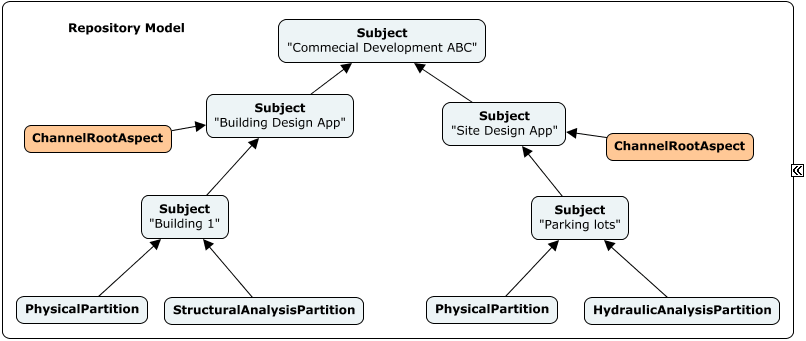Top of the World
BIS repositories have a strict hierarchical organization. This page describes the top of that hierarchy and how it functions as a table of contents for the repository as a whole. This table of contents consists of:
RepositoryModelSubjectsInformationPartitionElements
The following figure shows a simple example of a the top of the hierarchy. See Instance-diagram Conventions for details about the conventions used.

RepositoryModel
Every BIS repository has exactly one RepositoryModel that defines the top of the hierarchy. Elements can be inserted into or updated within the RepositoryModel, but the RepositoryModel itself cannot be deleted. The RepositoryModel sub-models the root Subject of a BIS repository.
The RepositoryModel is the only Model in a BIS repository that sub-models an Element contained within itself (the root Subject). Due to implementation details, this was easier than the RepositoryModel not sub-modeling any Element.
Subjects
Subjects are Elements that are used to identify things that the repository is about. The Subject class cannot be specialized (subclassed). The most important capabilities of Subject are:
- It can have a UserLabel (inherited from Element)
- It can have a Description
- It can have child
Subjects - It can have child
InformationPartitionElements
Subjects only exist in the RepositoryModel.
Every BIS repository has exactly one root Subject that describes what the repository as a whole is about.
- The root
Subject- like allSubjects - is contained by theRepositoryModel. - The root
Subjecthas no parent element as it is the top of theSubjecthierarchy. - The root
Subjectcan be updated, but it cannot be deleted. - the root
Subjectis sub-modeled by theRepositoryModel.
Child Subjects can be introduced to further organize the contents of the repository.
- Child
Subjects - like allSubjects - are contained by theRepositoryModel. - Child
Subjects have anotherSubjectas a parent. - A child
Subjectcan be identified as the root of an Editing Channel.
Editing Channels
An Editing Channel is a tree of models and elements below one Channel Root Subject element. Editing Channels segregate the contents of a BIS repository into sections to provide access control over which applications may change which data. See Editing Channels for more information about this topic.
InformationPartitionElements
As discussed in Modeling Perspectives Subjects can be viewed and modeled from multiple modeling perspectives (physical, functional, analytical, etc.). InformationPartitionElements are used to "partition" a Subject into different modeling perspectives.
When it is determined that a Subject is to be modeled from a particular modeling perspective, an InformationPartitionElement of the appropriate modeling perspective is added as a child of the Subject. That InformationPartitionElement is the start of a Model hierarchy representing the modeling perspective. The InformationPartitionElement is sub-modeled by a Model of the same modeling perspective.
In summary, Subjects capture a human-understandable hierarchical breakdown of what a BIS repository is about, organized according to the design of the applications that created their data, in terms of Editing Channels in a BIS repository. Furthermore, an InformationPartitionElement primarily declares the kind of data-modeling - modeling perspective - about its parent Subject that starts to take place under its submodel, to any software that consumes data in a BIS repository for different purposes.
Since the "Name" (e.g. Code and UserLabel properties) of an InformationPartitionElement is typically not meaningful in the context of a business, it is typically the Code of its parent Subject what is considered to be the "Name" of the Partition's submodel. Due to that reason, it is usually expected for a Subject to have only one InformationPartitionElement instance of a given modeling perspective, but it is not enforced. When such need arises, it is typically better addressed via child Subjects, each owning a different InformationPartitionElement instance of the same modeling perspective.
InformationPartitionElements always have a parent Subject and are never used outside of the RepositoryModel.
| Next: Single Responsible-Party Principle |:---
Last Updated: 11 June, 2025